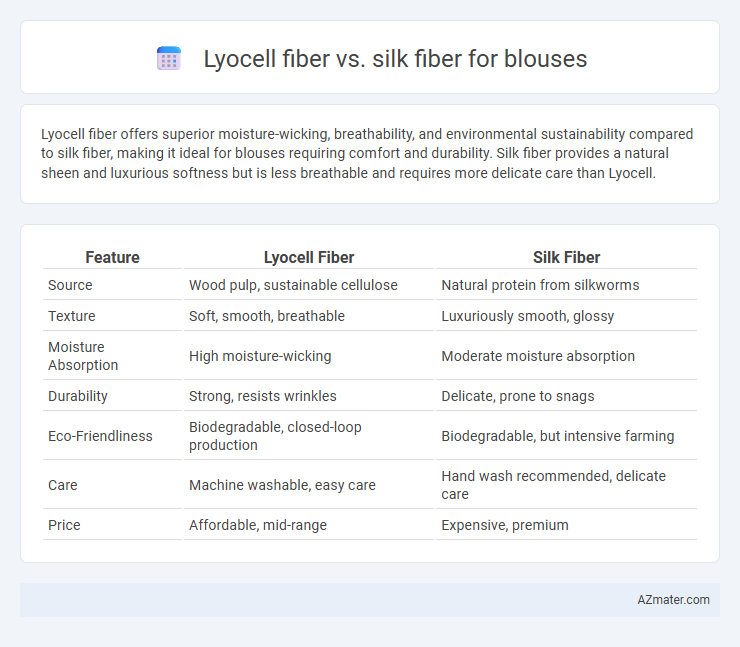Lyocell fiber offers superior moisture-wicking, breathability, and environmental sustainability compared to silk fiber, making it ideal for blouses requiring comfort and durability. Silk fiber provides a natural sheen and luxurious softness but is less breathable and requires more delicate care than Lyocell.
Table of Comparison
| Feature | Lyocell Fiber | Silk Fiber |
|---|---|---|
| Source | Wood pulp, sustainable cellulose | Natural protein from silkworms |
| Texture | Soft, smooth, breathable | Luxuriously smooth, glossy |
| Moisture Absorption | High moisture-wicking | Moderate moisture absorption |
| Durability | Strong, resists wrinkles | Delicate, prone to snags |
| Eco-Friendliness | Biodegradable, closed-loop production | Biodegradable, but intensive farming |
| Care | Machine washable, easy care | Hand wash recommended, delicate care |
| Price | Affordable, mid-range | Expensive, premium |
Introduction to Lyocell and Silk Fibers
Lyocell fiber, derived from sustainably sourced wood pulp, offers exceptional moisture absorption, breathability, and a smooth, soft texture ideal for blouses. Silk fiber, produced by silkworms, is renowned for its natural sheen, lightweight feel, and excellent thermal regulation, making it a luxurious choice for elegant blouse designs. Both fibers provide unique comfort and style attributes, with Lyocell emphasizing eco-friendliness and durability, and Silk highlighting luxury and natural protein fiber qualities.
Origins and Production Processes
Lyocell fiber is derived from sustainably harvested wood pulp, primarily eucalyptus, processed through a closed-loop system that recycles nearly all solvents, minimizing environmental impact. Silk fiber originates from silkworm cocoons and involves a labor-intensive process called sericulture, where the delicate extraction preserves the natural protein fiber. The contrast in production highlights Lyocell's eco-friendly manufacturing versus silk's traditional, handcrafted approach.
Environmental Impact Comparison
Lyocell fiber, derived from sustainably sourced eucalyptus wood using a closed-loop process, offers a significantly lower environmental footprint compared to silk fiber, which requires intensive water use and mulberry cultivation for silkworms. Lyocell production emits less greenhouse gas and utilizes fewer chemicals, while silk farming often involves habitat disruption and higher energy consumption. Choosing lyocell for blouses supports eco-friendly fashion by reducing water usage and pollutant discharge relative to traditional silk cultivation.
Texture and Comfort Differences
Lyocell fiber offers a smooth, breathable texture with excellent moisture-wicking properties, making it ideal for comfortable, lightweight blouses that stay cool and dry. Silk fiber provides a naturally lustrous, soft texture with a luxurious feel and excellent temperature regulation, offering a more elegant and rich comfort experience. While Lyocell is known for its durability and wrinkle resistance, silk delivers superior softness and a delicate drape that enhances the garment's sophistication.
Durability and Longevity
Lyocell fiber offers superior durability compared to silk, with higher resistance to abrasion and stretching, making it ideal for long-lasting blouses. Silk fibers, while luxurious and soft, tend to weaken over time due to exposure to sunlight and sweat, reducing their longevity in everyday wear. Blouses made from Lyocell maintain shape and strength through multiple washes, providing a more resilient fabric choice than delicate silk.
Breathability and Moisture Management
Lyocell fiber exhibits superior breathability and moisture management compared to silk fiber, making it ideal for blouses worn in warm and humid conditions. Its natural cellulose structure allows for efficient moisture absorption and quick drying, enhancing comfort and reducing sweat buildup. In contrast, silk offers moderate breathability but retains moisture longer, which can lead to a clammy feel during extended wear.
Care and Maintenance Needs
Lyocell fiber offers superior moisture-wicking properties and can be machine washed on a gentle cycle, making it easier to care for compared to silk fiber, which requires delicate hand washing or dry cleaning to maintain its luster and prevent damage. Silk fiber is highly sensitive to heat, sunlight, and detergents, necessitating careful storage and use of mild detergents for longevity. Lyocell's durability and resistance to shrinking provide practical benefits for blouse maintenance, while silk demands more meticulous handling to preserve its natural sheen and softness.
Cost and Affordability
Lyocell fiber is significantly more cost-effective than silk fiber, making it a popular choice for affordable blouses without compromising on softness and breathability. Silk fiber, known for its luxurious texture and natural sheen, comes with a higher price tag due to labor-intensive production and limited raw material availability. Consumers seeking budget-friendly blouse options often prefer lyocell for its sustainability and lower manufacturing costs while maintaining a premium feel.
Style Versatility and Aesthetics
Lyocell fiber offers exceptional style versatility with its smooth texture and matte sheen, making it suitable for both casual and formal blouses. Silk fiber provides a luxurious, glossy finish that elevates the elegance and visual appeal of any blouse. Both fibers enhance blouse aesthetics, but Lyocell excels in breathability and durability, while silk showcases timeless opulence and softness.
Choosing the Best Fiber for Your Blouse
Lyocell fiber offers exceptional breathability, moisture-wicking properties, and eco-friendliness, making it ideal for comfortable, sustainable blouses. Silk fiber provides a luxurious sheen, natural hypoallergenic qualities, and excellent drape, perfect for elegant, high-end blouses. Choosing the best fiber depends on whether you prioritize sustainability and comfort or luxury and softness in your blouse fabric.

Infographic: Lyocell fiber vs Silk fiber for Blouse
 azmater.com
azmater.com